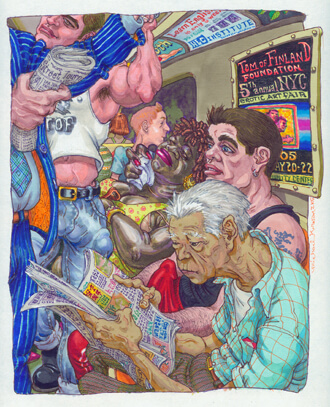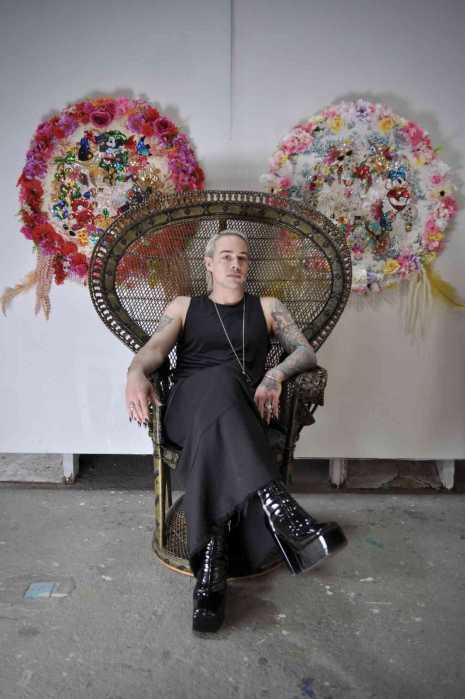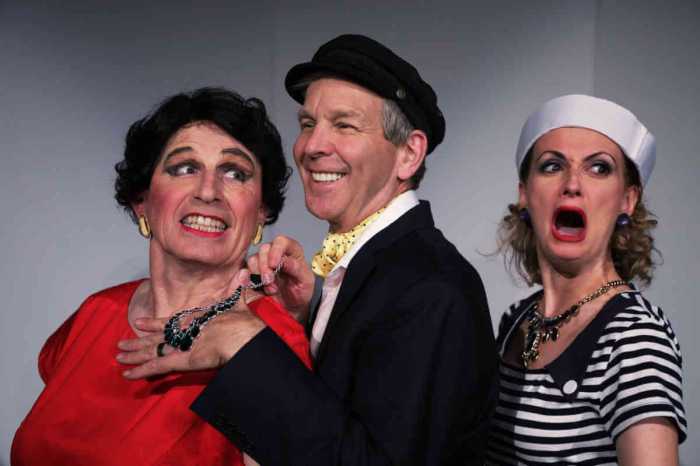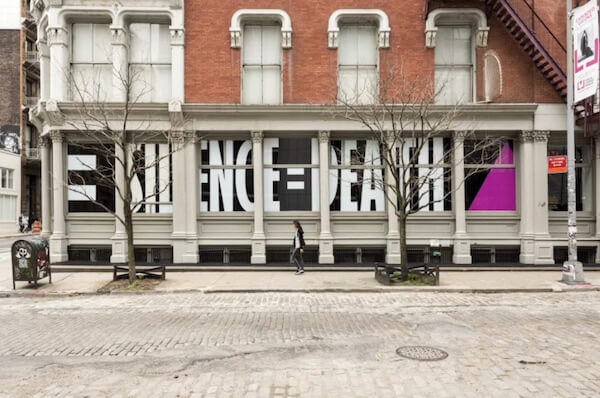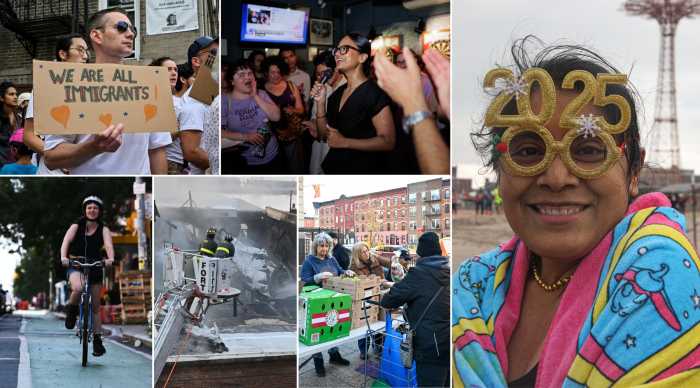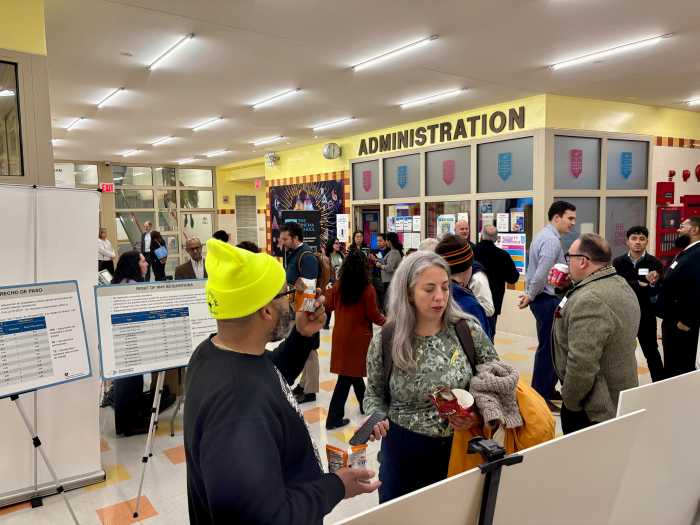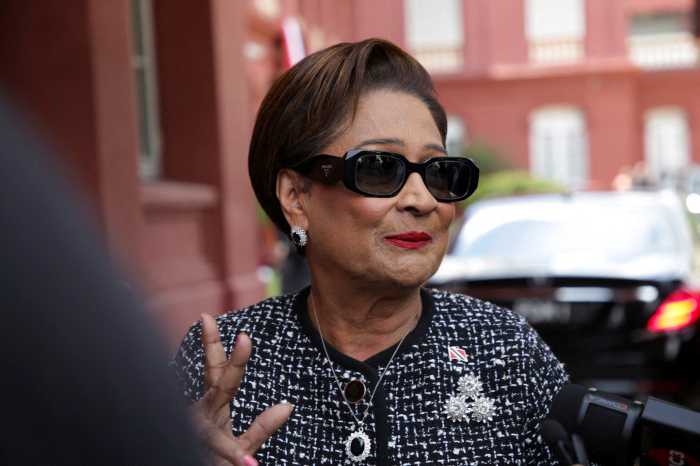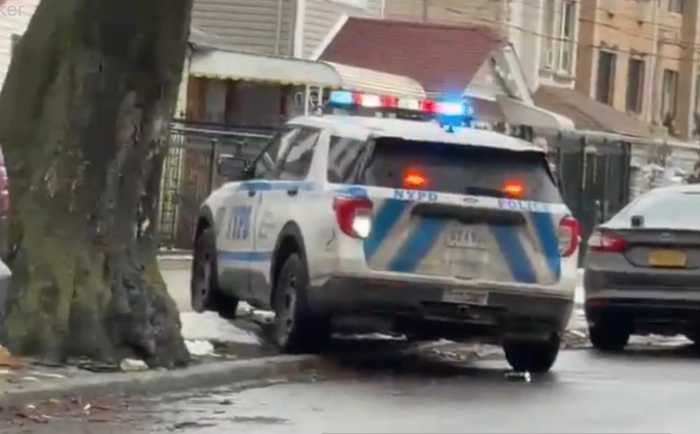Antonio Lopez's work appears in “Stroke.” | LESLIE-LOHMAN MUSEUM OF GAY AND LESBIAN ART
BY DAVID NOH | If you are a gay man of a certain age, magazines with titles like Honcho, Mandate, Torso, Drummer, Inches, and the gold standard — the Vogue of the genre, if you will — Blueboy will be familiar to you, maybe once stuffed under your mattress or hid away on a top closet shelf if you were a kid living at home, or nestled in a nightstand drawer if you were grown and on your own. We’re talking pre-Internet, pre-DVD, pre-VHS cassette, when one’s erotic fantasies were often generated from the printed page. Besides the glossy, ever-protuberant photographic layouts, there were erotic tales — these, too, often illustrated — that made you use your imagination to visualize the friskiness.
These are the images that comprise the very beautiful and very sexy exhibit “Stroke: From Under the Mattress to the Museum Walls,” on view at the Leslie Lohman through May 25.
Lovingly curated by master commercial illustrator Robert W. Richards, the vividly painted red and yellow walls of the gallery fairly burst with gorgeous testosterone by artists both well known — Antonio Lopez, Tom of Finland, George Stavrinos, and Mel Odom — and relatively obscure, if nonetheless talented, including Michael Kirwan, Benoit Prévot, Michael Broderick, and the more provocatively named Beau, Rex, Blade, Domino, and the Hun. Incredibly varied in their technique, media materials, and aesthetic approach, what they all do share is an unabashed adoration and celebration of the male form divine at its most literally ecstatic. The show is, at once, elegant, raunchy, and witty, as well as interactive, for in the center of the gallery is a counter stocked with vintage issues of the aforementioned magazines that any visitor can feel free to leaf through.
Leslie-Lohman’s “Stroke” legitimizes bygone era of gay erotica
“Yes, those are all from my own collection,” Richards chuckled when I met him one sunny spring afternoon for a personal tour of the exhibit. “In organizing this show, I knew that despite the sleazy reputations these magazines had there were great artists contributing to them, because, number one, they paid on the day of publication so you always got your money. That part was above board, but then the stuff would get stashed away or maybe returned to the artists. Many didn’t even bother to get their work back, but these big name artists did, and this was always at the back of my mind. Why is all this forgotten?
“I decided to do it four years ago and proposed it to the board here, of which I was not then a member. They said, ‘Okay, it sounds like the old Leslie-Lohman as opposed to what we’re doing now that we’re a museum.’ ‘You have to trust me,’ I told them. ‘I’ve always done things here that were successful and tasteful [laughs].’ I started gathering stuff four years ago, and a year ago I worked on this every single day and now it’s done.
“Gallery attendance has been staggering and the press has been unbelievable. Yesterday we received all this stuff on Russian blogs primarily because of this politically charged Michael Breyette image of two Russian men kissing in the snow. That’s all over Russia now, and all of Western Europe has been checking in. The New York Times covered us in the Sunday Styles section, a very good, spicy little piece called ‘Risqué Business.’ I wish we could run this through Gay Pride, but another show is coming in, as the museum schedule is fixed until 2017.”
Michael Breyette's work is part of Leslie-Lohman's “Stroke.” | ESLIE-LOHMAN MUSEUM OF GAY AND LESBIAN ART
A contemporary of many of the artists, Richards knew a number of them and offered personal reminiscences as well as serious artistic appraisal with his unerringly impeccable eye. The logo image for the exhibit is a dead sexy portrait of an elaborately pompadoured Latino man making a kissy face, who defines the term “papi chulo,” by the great Antonio Lopez: “This image is now all over Chelsea on lamp posts. I knew Antonio lightly, but I was really scared of him because in Paris, especially, he was always surrounded by these incredible looking people, Jessica Lange, Pat Cleveland, Jerry Hall, all these great beauties, not to mention the boys. I’d go to the famous Club Sept and be the wallflower, watching as they took over.
“But I loved him and Juan Ramos, his one-time boyfriend and collaborator, who’s also gone. Juan did all the art direction and a lot of the color, so it was collaborative, but never made public. It’s hard enough to make one person famous! Paul Caranicas is executor of the estate and has it all, beautifully kept, immaculate, and to go there is kind of frightening because there’s so much, every piece, not to mention hundreds of thousands of Polaroids [of models and celebrities] which haven’t surfaced. They’re as important as Warhol, but they’re not Warhol, although Antonio is inching his way.
“After him, I decided that I shouldn’t be doing fashion any more. I was drawing for Women’s Wear Daily, in that very Kenneth Paul Block school, which I loved and we were all trained in. Then Antonio came and started putting Saint Laurent dresses on black girls with big asses and tits, inventing crazy shoes, a whole new thing, and I thought, ‘Oh, man, the parade is rapidly passing us by,’ and it did. The era belonged to him and I couldn’t and wouldn’t compete.”
At the Chelsea Hotel, Lopez drew and collaborated with the great fashion designer Charles James, the subject of this year’s Metropolitan Museum Costume Institute show, and I asked if Antonio was going to be included in that.
“Yes, he will be in it,” Richards said. “I was at Paul’s, and the people from the museum came, although I didn’t see what they selected. Look at the fashion knowledge in this 1982 drawing [pointing to a punk portrait], nobody had gone this far. It was the beginning of the punk era and that skull-covered scarf you now see sold on every street corner!
“Stroke” helps rediscovery the work of Benoit Prévot. | LESLIE-LOHMAN MUSEUM OF GAY AND LESBIAN ART
“He had such a knowledge of anatomy, too. Look at the way that ass is tilted, the distribution of weight, and the power of that arm, with almost no detail. I could look at this stuff forever. He worked like a Renaissance artist in his big studio, with his boy and girl acolytes. I found a whole collection from one morning when he was looking for boy models, which he would find on the street. Instead of taking their cards, he drew them while he interviewed them, 26 little drawings. Incredible!”
I took drawing at Parsons from Professor Richard Rosenfeld, and was happy to see his intense Egon Schiele-esque erotic drawings on prominent display.
“Richard is still teaching at Parsons and in the process of retiring,” Richards said. “He lives on the East Side in an apartment filled with filing cabinets full of artwork. This is real drawing, highly erotic, and you can see all of his fashion experience. People ask how long did it take to do this and I say, ‘Two hours and 52 years!’”
Rosenfeld’s hardcore depiction of a leather man made Richards recall that the major magazines “had restrictions. You couldn’t show one man touching another’s genitalia, no penetration of any kind, and no fluids, because they were sold on newsstands and through the mail. You could buy this on a newsstand unsealed, but there was another genre of magazines that was sold sealed and could not be sold through the mail. They were very hardcore and not my thing. None of us were very hardcore, and there’s very little hardcore in this show, a few things.
“Look at this Rosenfeld sketch about fisting, how brilliantly and subtly it’s depicted. I found this beautiful piece right here in the gallery. We owned it and it was stuck in a drawer. We are currently trying to accession over 22,000 pieces into our collection, some in our permanent collection and some in the archive, a process that goes on for a very long time. I only care about the quality of the art but others care about the sociological aspects, so there are debates.”
My personal favorite work in the show is a frat house orgy by Michael Kirwan, which is like a Paul Cadmus with the sexuality amped up about 100 degrees, and Richards agreed: “It’s a masterpiece, and he does it all without models. He drew this out of his head. Look how many people are there, and each one is an individual, with great diversity. Of all the artists, Kirwan’s models are the most diverse, not all slick beauties. It’s all done in magic marker on the cheapest paper, so you can see the entire drawing on the back. He’s one of my all-time favorites, hard to handle, but delightful. If you want the boy next door, go next door, but he’s not working enough.”
Michael Kirwan's work at Leslie-Lohman's “Stroke” exhibition through May 25. | LIE-LOHMAN MUSEUM OF GAY AND LESBIAN ART
Kirwan, like a number of the artists, came to the exhibit’s opening “which was so crowded, 300 people. You could barely get near the artists for all their fans. Benoit, whose beautiful, big-selling work recalls the posters of Paul Colin and J.C. Leyendecker, came with a whole cadre of French people, such beautiful boys.”
Richards himself is represented by his work for Torso magazine: “Joe Namath actually wrote me a letter after he saw what I had done in the magazine. They gave me eight pages to do whatever I wanted, everything from Diana Vreeland to Ryan Idol. His letter said that this was the funniest thing in New York, and Vreeland also wrote me a letter thanking me for the ‘charming drawing’ of her.
“For Torso, I invented this boy named Toby, devoting big space to him and his different adventures. I guess he was the wishful me, with this rich boyfriend, Darryl, who paid the bills. And here is Bruce Weber, whom Darryl wanted to be photographed by. Growing up in Maine, there wasn’t anything like this for me, it was all in my head. You could buy these magazines, and I must admit I stole a few. I couldn’t buy them at our neighborhood drugstore. The guy would tell your parents.”
Mel Odom’s meticulously rendered, slightly surreal imagery definitely crossed over into the mainstream and was a big part of 1970s iconography, with his dreamy, opiated-looking models.
“This piece belongs to Mel, and he was reluctant to show it,” Richards explained. “It’s of his lover, who died of a heroin overdose. You see that monkey on his back but the technique is magnificent, staggering. Mel doesn’t draw anymore — it takes a day just to do one inch, it’s so intense — but he’s painting now on a big scale.”
There’s not a whole lot of Tom of Finland in the show.
“He’s very exposed already,” Richards said. “Jim French, in my opinion, was a better technician than Tom, but without the sociological impact. Because Tom taught gay men how they wanted to look. They had no idea — before him, when you went to a bar, you had to wear a suit. His was never my world, as he was deep into leather and all of that. This drawing belongs to the Tom of Finland Foundation. They have a big house in LA and on the top floor is his bedroom with his Nazi uniforms and all that stuff. I once slept in that room. It was creepy.”
Although a number of the artists are still alive, “some of these older guys have been through a lot and are quite bitter, and there are some real tragedies among them, like Blade. We own his estate from the 1940s on. He was one of those gay tragedies. When he was discharged from World War II, he was in San Diego and San Francisco, and word got out that he was doing this stuff and selling it privately. One day the cops burst in, beat him near to death, put all his work in the center of the room, and lit it on fire. He continued to work and later suffered from a big robbery of his stuff. I knew him quite well, a wonderful man and close friend of [photographer] George Platt Lynes, that crowd, a brilliant artist and lovely man. I have been commissioned to do a book of the exhibit which will feature many more artists I couldn’t include, and also biographies of the artists, because there isn’t such a book.”
So what ended all of this?, I asked Richards.
“It’s very definite,” he said. “First of all, there was VHS tape and suddenly you could have all boys in the magazines doing what you wanted them to do, once the machines became available. Then came the CD, which made it even more glamorous, and the DVD, which was more connected to digital. And then the Internet killed the magazines completely. I think there are a few stragglers left, really low end with nothing of quality in them, mostly boys off the street, pimply-assed, drugged, and sleazy.”
Yes, this era has pretty much ended, but if you want to relive it — maybe revisit your own past — and get a sneaky thrill from what was once kept covertly and is now gloriously displayed and fully legitimized, get your keister down to Wooster Street, posthaste.
Full confession: after our walk through the gallery, such was the undying, wicked potency of these images, I had to admit, “I’m so damned horny now!”
“That’s the idea,” Richards smiled.
STROKE: FROM UNDER THE MATTRESS TO THE MUSEUM WALLS | Leslie-Lohman Museum of Gay and Lesbian Art | 26 Wooster St., btwn. Grand & Canal Sts. | Through May 25: Tue.-Wed., Fri.-Sun. noon-6 p.m.; Thu. noon-8 p.m. | leslielohman.org

